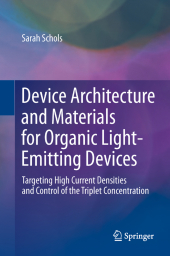 Neuerscheinungen 2014Stand: 2020-02-01 |
Schnellsuche
ISBN/Stichwort/Autor
|
Herderstra▀e 10
10625 Berlin
Tel.: 030 315 714 16
Fax 030 315 714 14
info@buchspektrum.de |

Sarah Schols
Device Architecture and Materials for Organic Light-Emitting Devices
Targeting High Current Densities and Control of the Triplet Concentration
2011. 2014. xv, 154 S. 235 mm
Verlag/Jahr: SPRINGER NETHERLANDS; SPRINGER 2014
ISBN: 9400794037 (9400794037)
Neue ISBN: 978-9400794030 (9789400794030)
Preis und Lieferzeit: Bitte klicken
This book covers the design of new device and material concepts for organic light-emitting devices, demonstrating a new LED architecture, the OLED with field-effect electron transport, which is a hybrid between a diode and a field-effect transistor.
Device Architecture and Materials for Organic Light-Emitting Devices focuses on the design of new device and material concepts for organic light-emitting devices, thereby targeting high current densities and an improved control of the triplet concentration. A new light-emitting device architecture, the OLED with field-effect electron transport, is demonstrated. This device is a hybrid between a diode and a field-effect transistor. Compared to conventional OLEDs, the metallic cathode is displaced by one to several micrometers from the light-emitting zone, reducing optical absorption losses. The electrons injected by the cathode accumulate at an organic heterojunction and are transported to the light-emission zone by field-effect. High mobilities for charge carriers are achieved in this way, enabling a high current density and a reduced number of charge carriers in the device. Pulsed excitation experiments show that pulses down to 1 Ás can be applied to this structure without affecting the light intensity, suggesting that pulsed excitation might be useful to reduce the accumulation of triplets in the device. The combination of all these properties makes the OLED with field-effect electron transport particularly interesting for waveguide devices and future electrically pumped lasers. In addition, triplet-emitter doped organic materials, as well as the use of triplet scavengers in conjugated polymers are investigated.
Contents. List of symbols and abbreviations.
1 Introduction. 1.1 Organic semiconductors. 1.2 State of the art organic light-emitting devices. 1.3 Organic semiconductor lasers. 1.4 Book outline.
2 Materials and experimental techniques. 2.1 Sample fabrication. 2.2 Device characterization.
3 OLEDs with field-effect electron transport. 3.1 Device fabrication. 3.2 Device operation. 3.3 Device performance. 3.4 Improvement of the external quantum efficiency. 3.5 Summary and conclusions.
4 Devices based on diperfluorohexyl-quaterthiophene derivatives. 4.1 Characterization of DFH-4T and DFHCO-4T. 4.2 Devices based on DFH-4T. 4.3 Devices based on DFHCO-4T. 4.4 Comparison. 4.5 Summary and conclusions.
5 Control of the triplet concentration. 5.1 Pulsed excitation of OLEDs with field-effect transport. 5.2 Triplet excitation scavenging. 5.3 Summary and conclusions.
6 Triplet-emitter doped organic materials. 6.1 Triplet dynamics and charge carrier trapping. 6.2 Optical pumping of triplet-emitters. 6.3 Summary and conclusions.
7 Value of OLEDs with field-effect electron transport for lasing. 7.1 Potential as laser device configuration. 7.2 Optically pumped lasing experiments. 7.3 Device with integrated field-effect and photonic features. 7.4 Summary and conclusions.
8 General conclusions and future outlook. 8.1 Overview of the main results. 8.2 Suggestions for further research.
Bibliography.


